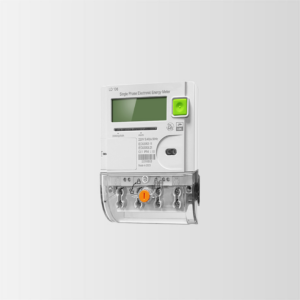Electronic energy meters are game-changers in tracking and managing our electricity use. They give us a crystal-clear picture of our electricity and help us understand our energy choices. This is why they are getting famous as the smart meter market is projected to reach a massive $54.34 billion by 2030. Electronic energy meter is a symbol of sustainability by promoting energy efficiency and awareness. When using smart energy meters, users often have questions about reading them. In this article, we address common queries and uncertainties related to electronic energy meters and electricity readings.

(Copyright photo from: https://www.freepik.com/free-photo/man-electrical-technician-working-switchboard-with-fuses-uses-tablet_33379023.htm#fromView=search&page=7&position=51&uuid=51355329-354d-4bf2-a63d-70e61bc67dad)
What is an Electronic Energy Meter and How does an Electronic Meter Work?
Before knowing people’s doubts, the first thing is to understand what an energy meter is. An electronic energy meter is a modern device that measures the amount of electricity consumed by any electrical system. Electronic energy meters measure current and voltage in a circuit, calculating power by multiplying these factors. Power is measured in watts and accumulates over time to provide energy consumption in kilowatt-hours (kWh), the standard unit on electricity bills. The meter uses sensors to convert current and voltage signals, processed by a microprocessor for power calculations and accurate energy consumption recording.
FAQs about Electricity Reading on Meter
As you see data on electronic energy meters and see electricity readings, several questions can come to your mind:
-
What is the Reading in kWh?
The electricity reading shown in kWh (kilowatt-hours) is a measure of energy consumption. It reflects the cumulative amount of electricity used over time. For example, if a 100-watt light bulb is used for 10 hours, it consumes 1 kWh of energy:
100 watts x 10 hours = 1,000 watt-hours = 1 kWh
This kWh figure is what you will see on the meter display, and it is the basis for calculating your electricity bill.
-
How to Do Electricity Reading?
To read an electronic energy meter, you should know the figures on the electronic meters:
- Total kWh: This is the main figure you’ll be interested in. As mentioned above, it represents the total amount of electricity consumed since the meter was installed or since the last reset.
- Tariff Indicator: Some meters may display different rates for different times of day or seasons. This indicator shows which tariff is currently in effect.
- Instantaneous Usage: This figure shows the current rate of energy consumption in real-time, usually measured in kilowatts (kW). It can help you understand how much electricity you use at any moment.
- Previous Readings: On some meters, you may be able to view previous readings or historical data. This allows you to track your usage over time and compare it to previous periods.
As you know the meaning of the figure, electricity reading becomes simple and easy:
- Find your electricity meter, usually positioned near the entrance of your home or property
- Look at the numbers displayed on the meter from left to right and categorize the figures (typically measured in kWh)
- Compare the current reading to your previous electricity bill or record to see your contribution to sustainability
-
How Many kWh is Normal?
After reading the electronic energy meters, people might wonder if these figures were too high or low. How many kWh is normal? According to the US Energy Information Administration, the average daily electricity consumption for households in the US is 29 kilowatt-hours (kWh). This indicates a monthly average usage of approximately 870 kWh.
However, normal energy consumption is subjective and varies depending on factors such as household size, number of appliances, and usage habits. It is beneficial to compare your readings over similar periods to gauge how much electricity consumption is normal for your needs.
-
Can the Meter Reading Be Wrong?
Electronic energy meters are well-known for their precision. Having a high-quality meter ensures accurate electricity readings, preventing errors like calibration errors. Additionally, preventing meter tampering or unauthorized access ensures the integrity of the readings. It’s essential to install a high-quality and secure electronic energy meter, periodically verify meter readings, and report any discrepancies to your utility provider for resolution.

Electronic Energy Meter Recommendation: Londian LD106
Our Londian LD106 single-phase energy meter is known for its precision, reliability, and versatility. Here’s why:
-
Wide Voltage Operating Range
Equipped with a broad reference range (220-240V) and operating range (0.7Un-1.3Un), our single-phase electronic energy meter efficiently operates in fluctuating power conditions, showcasing adaptability to various voltage levels.
-
Smart Metering Capabilities
Offers highly accurate readings with exceptional measurement precision and seamless data exchange, facilitating integration with energy management systems and ensuring an exact electricity reading.
-
Anti-Tampering Measures
Incorporating features like load imbalance detection, cover opening alerts, and magnetic field monitoring, ensuring energy data and meter security and integrity.
-
Compliance with Standards
Meets DLMS and IEC1107 standards, ensuring future-proof compatibility and readiness to meet evolving demands in the energy sector
Conclusion

Our Londian’s electronic energy meter, like LD106, can deliver accurate electricity readings, letting you master energy consumption simply and easily. We, Londian, are a smart meter company, backed by a rich history and long experience in the power and energy storage sectors. With our robust infrastructure and expertise in production, research, and service, we deliver high-quality electricity solutions. This is evident in our supply of nearly 30 million meters and various energy storage products globally. Want to learn more about electronic energy meters? Just contact us now!
